X-trader NEWS
Open your markets potential
Stablecoins heading towards mainstream: Panoramic analysis of onshore applications

- Stablecoins have gained regulatory legitimacy in two major economies, namely China (Hong Kong) and the United States, and have ushered in a wave of popularity. Unlike offshore stablecoins, which are mostly used for cryptocurrency speculation and informal economic activities, we believe that onshore stablecoins will mainly focus on two areas: "open-source digital wallets" in payments and "open clearinghouses" in inter-institutional settlements.
- Compared with centralized digital wallets in the Web2 era, digital wallets using stablecoins and blockchain will have much lower thresholds in both technology and commercial promotion. Technically, stablecoin payments can be fully based on existing blockchain technologies, token standards, and crypto wallets. Commercially, consumer platforms such as retailers, e-commerce, and social networks can promote stablecoin payments for their own interests without the need for collaboration, while forming a joint force to promote stablecoins. Based on these two points, stablecoin payments can be regarded as "open-source digital wallets".
- With these advantages, stablecoins may pose a challenge to the credit card-dominated payment system, and issuing banks, which are the main collectors of transaction fees, will undoubtedly be impacted. At the same time, bank card networks such as Visa and Mastercard, as well as payment terminal providers like Stripe, will instead benefit from the increase in the types of "currencies" in the payment network, thereby consolidating their roles in the payment system.
- In terms of fund transfers, stablecoins will be able to play the role of an "open clearinghouse". Through inter-bank settlements of stablecoin deposits/withdrawals and on-chain transfers, their structure is highly similar to traditional inter-bank transfers conducted by clearinghouses. At the same time, stablecoin-based systems can further improve real-time performance, scalability, and cross-regionality. The long-standing inefficiency of cross-border settlements is precisely due to the lack of international clearinghouse roles. Therefore, stablecoins, as an open cross-regional clearing service, are crucial for solving the inefficiency of cross-border transfers.
- Existing remittance operators, such as Wise and Airwallex, improve remittance efficiency by acting as cross-border clearinghouses. Operators bridge with banks in various countries through their own ledgers and capital pools in different countries, avoiding actual cross-border fund transfers. However, if banks achieve the same efficiency through stablecoin clearing, this model may face challenges. On the other hand, it should be noted that not all remittance solutions of blockchain companies truly utilize the core capabilities of stablecoins. For example, cross-border transfers through centralized cryptocurrency exchanges only involve the internal ledgers of the exchanges and not blockchain transactions, so they should be regarded more as remittance operator businesses rather than stablecoin-based solutions.
Stablecoins Going Mainstream
In the past two months, stablecoins have completed relevant legislation in the world's largest economies, the United States and China (through Hong Kong). The completion of these legislations marks the transformation of stablecoins from a tool mainly used within the small circle of virtual currencies to a new financial technology innovation recognized by the mainstream economy.
In the United States, on July 18, the "GENIUS Act" was officially signed, clarifying the path for the compliant use of stablecoins. In the past few months, the bill has been reviewed and discussed by the Senate and the House of Representatives. As the possibility of the bill's passage has continued to increase, various institutions and large enterprises have begun to participate in the issuance and use of stablecoins, such as:
- Payment service providers starting to support stablecoins: Stripe, Visa, Shopify, PayPal, etc.
- Social media and e-commerce platforms considering adopting stablecoin payments: Meta, Amazon, Walmart, etc.
- The four major U.S. banks planning to form an alliance to issue stablecoins: including JPMorgan Chase, Bank of America, Wells Fargo, and Citigroup.
Hong Kong also passed the "Stablecoin Ordinance" in May 2025, which came into effect on August 1, 2025. This indicates that Hong Kong, as China's financial gateway, has opened up to financial activities related to stablecoins. In addition to the Hong Kong dollar, the bill also allows licensed issuers to issue stablecoins denominated in other currencies, so its impact on international currency circulation far exceeds that of Hong Kong itself. Interestingly, the types of institutions that have responded most actively to this opportunity are very similar to those in the United States, including:
- Payment service providers: Ant Group (including Ant International and Ant Digital Technology), Lianlian International, etc.
- E-commerce platforms: JD Digits plans to launch stablecoins, while Alibaba can do so through Ant Group.
- Large banks: Standard Chartered Bank plans to apply for the issuance of stablecoins through a joint venture with Animoca Brands and Hong Kong Telecom.
Against this background, this article aims to provide readers with a framework to understand the main scenarios where onshore stablecoins can play a role in the economy and explain the main participation purposes of the above-mentioned institutions. We will divide the discussion into two main application categories:
- Payments, i.e., consumers paying merchants
- Transfers, i.e., remitters transferring funds across banks to recipients
Strictly speaking, payments can also be a type of transfer. The reason why we discuss these two use cases separately is that the existing mainstream solutions for realizing non-cash payments and transfers are different, and thus have different pain points. The former is mainly through credit card payments supported by card networks, while the latter is mainly bank transfers. In the following, we will discuss the main problems of existing solutions, existing alternative solutions, and the new opportunities brought by stablecoins.
Payments
Cash and credit cards remain the main payment methods in most regions. Among them, credit card transactions, as the main non-cash option, are processed through bank card networks such as VISA and Mastercard (hereinafter referred to as card networks). Payments made through card networks generally involve the following steps:
1. Merchant initiation: The merchant requests payment information from the customer through its terminal POS machine, and the customer provides it by swiping the card offline or filling in credit card information online.
2. Authorization request: The POS system selects the corresponding card network based on the information provided by the customer and sends a payment authorization request to the issuing institution through this network.
3. Authorization approval: The issuing institution approves the transaction after verifying the customer's balance or credit limit. This confirmation information is transmitted back to the POS terminal through the card network and finally returned to the customer for confirmation, completing the payment authorization.
4. Clearing and settlement: For authorized payments, the POS terminal initiates the clearing and settlement process with the acquiring institution (such as the bank used by the merchant). The acquiring institution sends the total batch-processed collection amount to the issuing institution through the card network. The issuing bank then completes the settlement through traditional inter-bank transfer channels.
5. Foreign currency transactions: In transactions involving foreign currencies, the issuing institution will conduct currency exchange and complete the settlement through methods such as SWIFT transfers.
In this process, the card network acts as an information transmission layer to ensure that the financial service providers used by customers and merchants can communicate and clear regardless of how different they are.
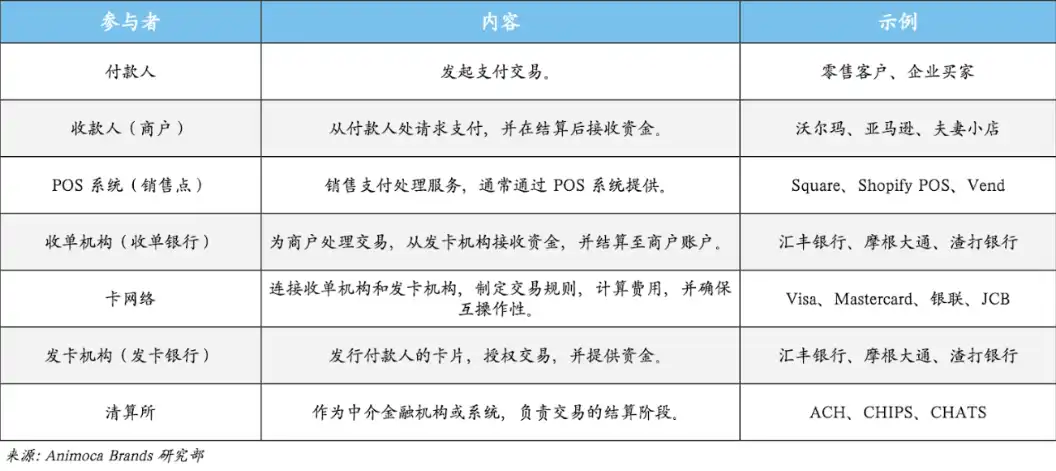
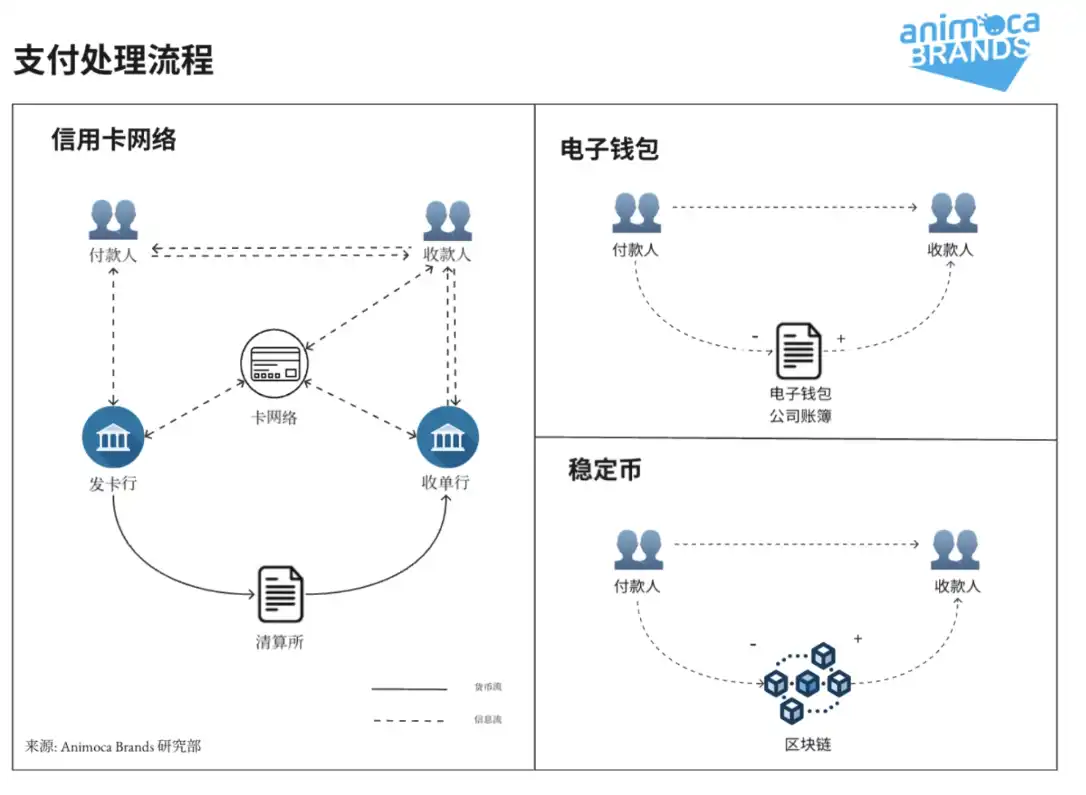
The existence of credit cards and card networks has significantly improved the convenience of non-cash payments, but they are often criticized for their high transaction fees. Each credit card transaction automatically deducts 2-3% or more from the amount paid by the customer as a handling fee. This fee constitutes a heavy burden for low-margin businesses.
However, upon closer inspection, the card networks themselves are not the main cause of high fees. Credit card transaction fees can be roughly divided into three parts: the "assessment fee" paid to the bank card network, the "processing fee" for the sales terminal, and the "interchange fee" for the issuing bank. Among these three, the fee charged by the card network is the smallest, accounting for only 0.15% of the transaction. For example, Visa processes $16 trillion in transactions annually, while its annual revenue accounts for only 0.2% of the total transaction volume. The bulk of the transaction fee is the interchange fee (1-3%) paid to the issuing bank. This fee is mainly used to cover the costs and risks of the services provided by the bank, such as credit default risks and consumer protection. For consumers who need to use credit, this rate is not excessive. For issuing banks, as credit card business involves default risks, a 2% fee precisely reflects the professionalism of the bank's risk management rather than inefficiency.
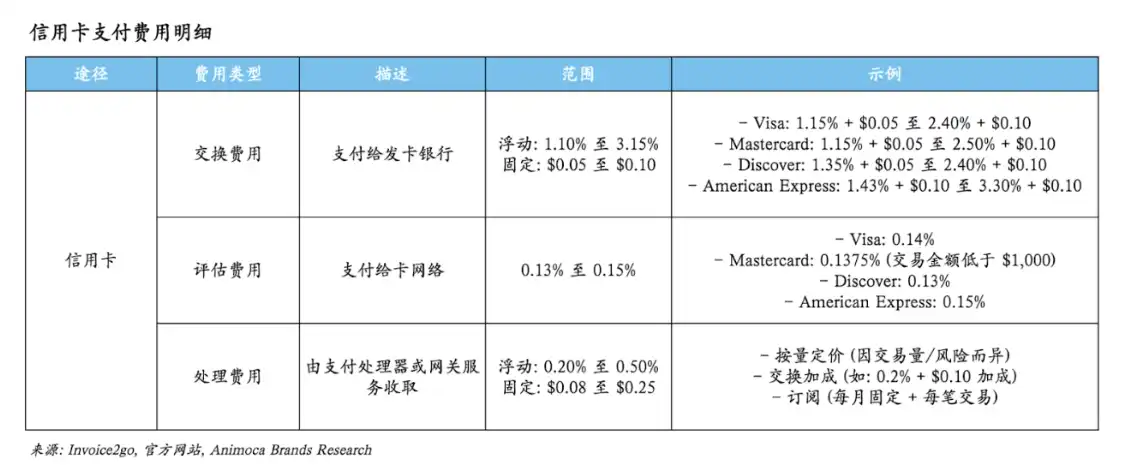
Therefore, the key issue with credit card fees does not lie in their high cost, but in the fact that consumers have adopted them as the default option. Whether they need a credit limit or not, they will prioritize using credit cards over other methods. The root cause of this consumer preference is a mismatch between the party choosing the payment method and the party bearing the fees: consumers select the payment method, while merchants bear the transaction costs. This mismatch gives issuing banks room to operate—they can use part of the fees to "bribe" consumers with rewards and points to gain their preference. This strategy is highly effective; a large number of consumers will favor credit cards for better cashback and point benefits, even over debit cards, cash, or digital wallets that have lower transaction fees but no points, even when they do not need credit-based consumption.
In addition to high transaction fees, card networks also incur substantial cross-border fees in cross-border payments, further driving up transaction costs. The root cause of this problem is that settlements between issuing and acquiring banks rely on traditional interbank channels. We will explore the topic of cross-border settlement in the transfer section.
From the above discussion, we can roughly understand the attitudes of various participants in the payment system toward stablecoins:
1. Merchants suffer the most in the credit card system and thus have the strongest motivation to seek alternatives. Companies like Walmart, Amazon, and JD.com, with their extensive sales networks, have shown strong interest in stablecoin payments as an alternative.
2. Card networks such as Visa and Mastercard account for a small proportion of transaction fees and can support various currencies, including stablecoins. Therefore, card networks themselves are not opposed to stablecoins. On the contrary, as more stablecoins enter daily transactions, card networks may become more important due to their bridging function. Moreover, with stablecoins, the settlement process of payment networks can be simplified, allowing card networks to further participate in settlements and thus play a larger role in the entire payment process. As early as 2021, Visa demonstrated the potential of cross-border settlements with issuers through stablecoins.
3. Terminal (POS) solution providers can expand their product lines by supporting new payment methods. Stablecoins will not disrupt their current role; instead, they will give terminal solution providers opportunities to enter services such as acquiring, deposit, and withdrawal. Stripe's acquisitions of Bridge and Priv (wallet services) are evidence of this trend.
Stablecoin-based "Open-Source Digital Wallets"
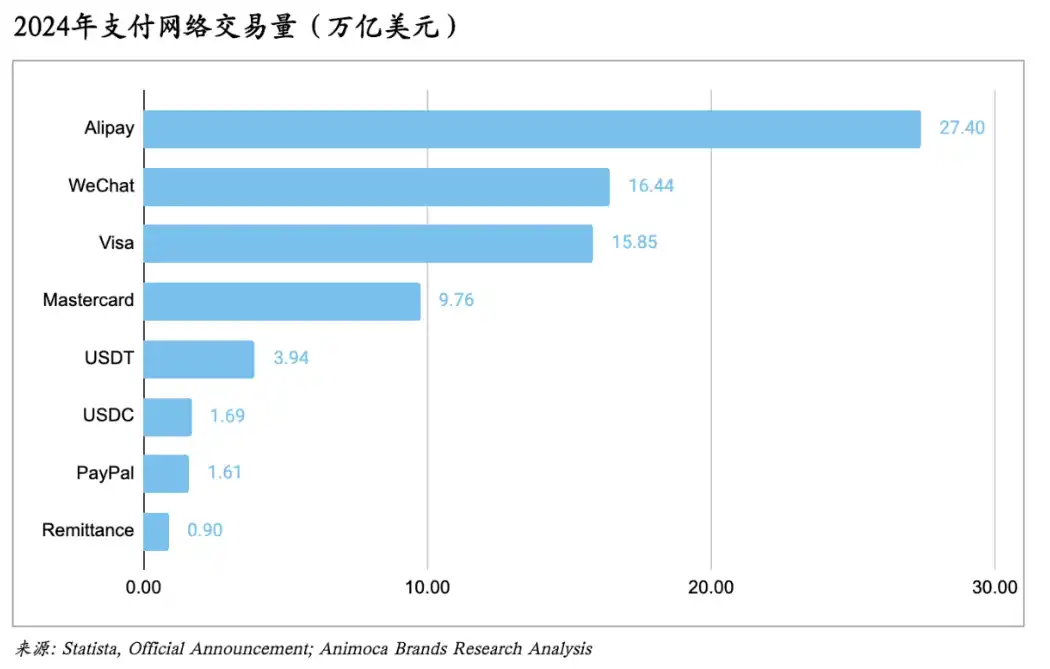
Digital wallets were first launched by PayPal in the United States, and after many years, they successfully dominated payments in China, as well as in many developing countries in Southeast Asia and Africa. Compared with bank card payments, digital wallets have several advantages, such as:
- Registering a digital wallet is much easier than opening a bank account. Users can start using the digital wallet by simply completing online registration like signing up for a website. Some digital wallet services offer offline channels for recharging or withdrawing funds.
- As a product of the Web2 era, digital wallets are inherently compatible with online transactions, which has led to the rapid growth of their application scenarios in the mobile phone era and their gradual expansion to offline merchants.
- Due to fewer participating nodes in the payment process, digital wallet transactions are cheaper than those based on card networks. For example, Alipay charges merchants 0.6% and offers free peer-to-peer transfers between users.
Stablecoin payments have many similarities with digital wallets, so they can be regarded as a new form of digital wallet service. The similarities include:
- The "funds" in wallet accounts are all tokenized representations of fiat currencies on the ledger, which need to be maintained with 100% collateral in accordance with regulatory requirements.
- Payments between digital wallets are just a transaction record on the ledger. The only difference is that digital wallet transaction records are stored on the proprietary ledger of the affiliated company (such as Alipay), while stablecoin payments are recorded on a decentralized blockchain ledger.
- In terms of user interface, the user interfaces and interaction methods of digital wallets and digital currency wallets are basically the same. For example, both support functions such as "QR code payment" and "payment code".
At the same time, due to its decentralized architecture, stablecoin payment is a more open "open-source digital wallet" compared with products of the Web2 era. For example:
- The issuance of stablecoins, which involves providing compliance, collateral, and contract deployment, can come from multiple institutions, such as Tether and Circle.
- The deposit and withdrawal of stablecoins are provided by independent licensed institutions, such as Transak.
- The ledgers for stablecoin transactions can use different blockchains, such as Ethereum, Solana, TON, etc.
- Users can use any wallet that supports these blockchains to make payments and receive funds.
- Cross-(wallet) ledger payments can be processed through various on-chain cross-chain protocols, such as LayerZero.
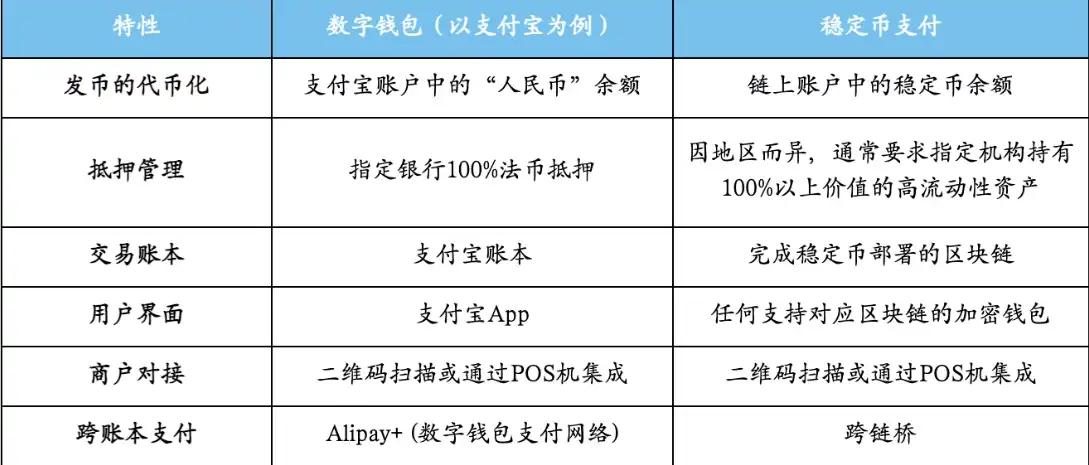
Therefore, in the process of popularizing stablecoin payments, on the one hand, we can learn from the successful strategies of digital wallets, and on the other hand, through their more open characteristics, enter areas that digital wallets could not conquer before. For example:
- Occupy consumption scenarios: Digital wallets acquire a large number of customers by targeting applications with huge user groups and consumption demands. Such as Alipay (e-commerce), WeChat Pay (social), Grab Pay (ride-hailing), and public transportation payments like Suica, EasyCard, and Octopus. Stablecoin payments are likely to follow a similar path.
- Opportunities in developed economies: Stablecoin payments provide developed economies such as the United States with another opportunity to challenge the dominant position of credit cards. The open-source nature of stablecoins allows merchants, stablecoin issuers, blockchain operators, cryptocurrency wallets, payment service providers, etc., to make efforts in the stablecoin track without coordination, and thus form a joint force. This method will be much more powerful than promoting a single digital wallet service (such as PayPal) alone. Considering that 28% of the U.S. population already owns cryptocurrencies, once major consumer platforms start supporting stablecoins, the user scale will grow rapidly.
- Financial inclusion: Digital wallets have promoted financial inclusion by realizing the conversion from cash to online payments and providing services such as deposits, loans, and transfers to people with insufficient access to banking services. As an open-source digital wallet, stablecoins can further continue this trend by lowering technical thresholds. Payment service providers in various countries do not need to conduct in-depth technical development, but only need to graft local stablecoins onto existing blockchain infrastructure and applications.
- Advantages in marketing: Stablecoin payments will require a lot of promotion work. This includes persuading merchants to accept new payment forms, upgrading point-of-sale (PoS) systems, and attracting users through incentives (such as discounts, rewards, etc.). In this regard, stablecoins, because their circulation can generate interest through collateral, can provide the necessary funds for marketing activities.
- Card networks remain important: The popularity of digital wallets does not eliminate the need for intermediate transaction networks. For example, digital wallets still rely on Alipay+ to connect merchants with different wallets; the Octopus App supports payments through UnionPay PoS, etc. Stablecoins will also need support from various payment networks. Existing payment infrastructures (such as Visa, Stripe, etc.) can expand their service scope by adding support for stablecoins. For example, Stripe has acquired multiple crypto services to support the growing needs of merchants. And Visa has also clearly expressed its vision of supporting digital currencies.
- On-chain payment networks: The on-chain part of stablecoin payments will also require routing and exchange services to support payments between stablecoins from different issuers or the same stablecoin on different blockchains. Circle's CPN (Circle Payment Network) has been able to realize cross-chain routing and settlement for its own USDC. The further development of this demand will be a new opportunity for traditional networks and on-chain native protocols.
Transfers
Interbank transfers are one of the pillars of the modern economy. Even though digital wallets can handle a large number of small personal transfers, most fund transfers still occur through banks. Due to their importance, every country and region will establish necessary infrastructure (such as clearinghouses) to enable efficient domestic transfers. However, due to the lack of cross-border clearinghouses, cross-border transfers are still relatively inefficient. The SWIFT telegraph network, established in the 1970s, is still the cornerstone of interbank cross-border transfers today, 50 years later.
Domestic transfers
Domestic transfers are the main form of capital flow. In 2024, China's domestic payment system processed 12,450 trillion yuan (approximately 1.8 trillion U.S. dollars) in transfers. At the same time, the amount processed domestically in the United States was comparable.
These interbank transfers are usually realized through clearinghouse services provided by central banks or banking associations. Under the clearinghouse structure, banks do not need to settle directly with each other. Instead, participating banks open accounts in the clearinghouse, and transfers are realized through transactions on the clearinghouse's ledger. In this process, there is no direct flow of funds between banks, but only deposits and withdrawals between banks and the clearinghouse. Taking the systems of the United States and China as examples:
Banks in the United States use multiple sets of clearing services. The Federal Reserve provides FedWire and FedNow for large and small transfers. The Clearing House Association provides CHIPS and RTP as parallel products. In addition, the ACH system, which has a history of more than 50 years and is managed by Nacha (a non-profit banking association), is still adopted by most U.S. banks due to its compatibility with old systems.
Banks in China rely on clearing systems provided by the People's Bank of China, including HVPS, BEPS, and IBPS, to manage transfers of different scales and time requirements. In Hong Kong, China, the Hong Kong Monetary Authority provides CHATS (Clearing House Automated Transfer System) for large interbank transfers and FPS (Faster Payment System) for instant fund transfers. Just this year, "Cross-border Payment Connect" was launched, connecting the People's Bank of China's IBPS and the Hong Kong Monetary Authority's FPS to realize instant fund transfers between mainland China and Hong Kong, as well as the exchange between Hong Kong dollars and RMB.
In addition, the People's Bank of China also provides CIPS (Cross-border Interbank Payment System) for offshore RMB (i.e., CNH) transactions. Through CIPS, overseas banks can directly conduct RMB transfers with domestic Chinese banks or other overseas CIPS participating banks without relying on the SWIFT system. In contrast, cross-border U.S. dollar transfers are mainly realized through CHIPs, which can only be cleared in New York. All cross-border U.S. dollar transfers require banks to first send U.S. dollars to their New York branches through internal and external transfers before proceeding with subsequent operations.
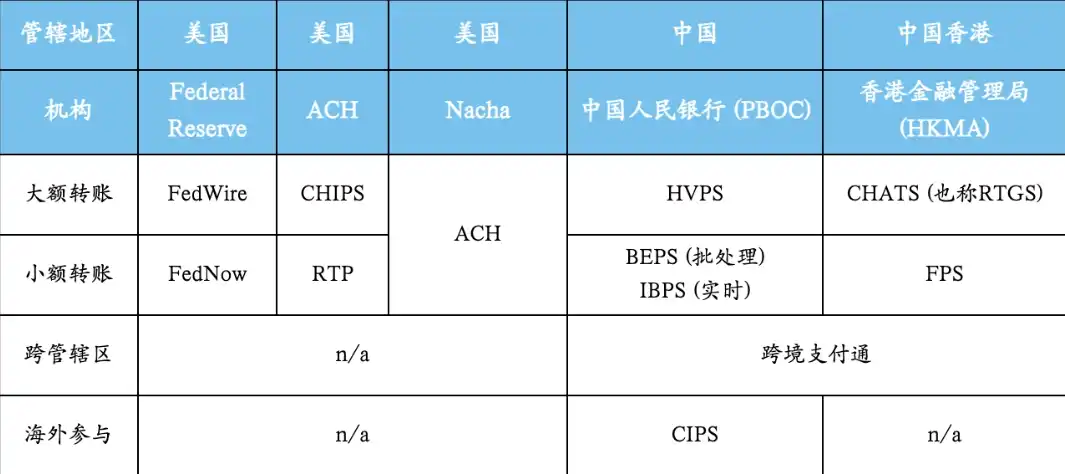
From the above analysis, it can be seen that existing clearing systems can cover a wide range of transfer application scenarios, but they still have their limitations:
- System fragmentation: The maintenance of old systems and the difficulty of cross-bank coordination have led to the coexistence of multiple clearing services.
- Access thresholds: Clearinghouses are usually limited to banks within a single country and only support local fiat currencies. This is obviously insufficient for currencies that need to flow globally.
- System availability: Many clearing systems do not support 24/7/365 operation. They are usually closed on weekends and evenings. Even 24/7 systems still need to set aside time for system maintenance and upgrades.
- Cost and speed: Most clearing services use batch processing, which requires a trade-off between cost and time.
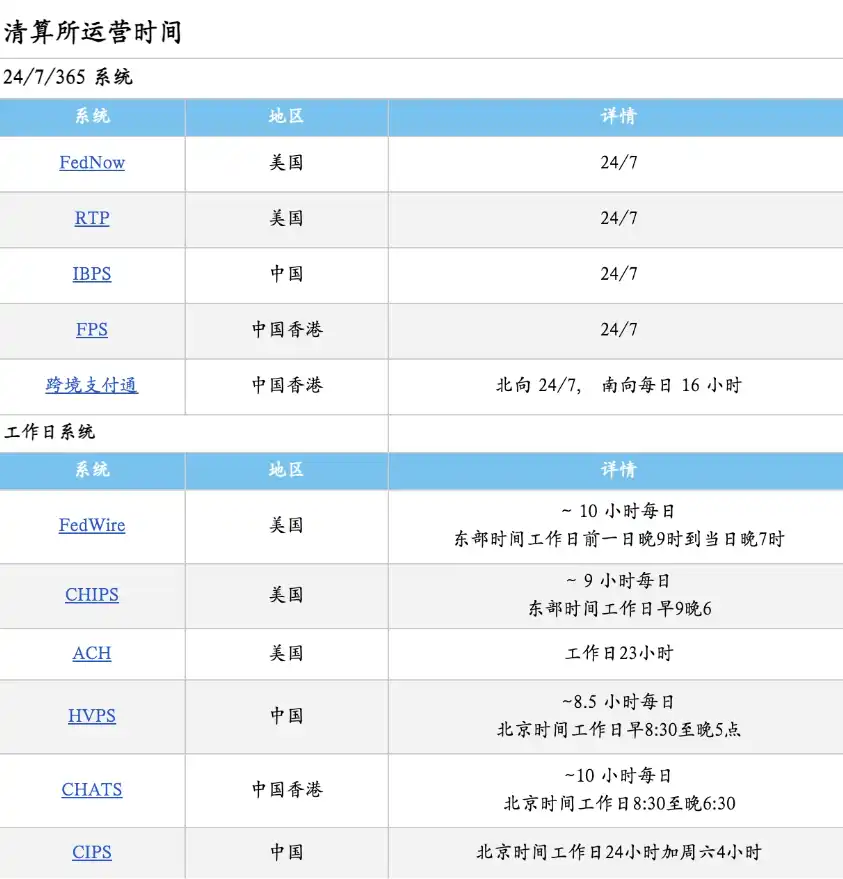
Stablecoin-based "Open Clearinghouse" Stablecoins can improve the efficiency of transfers in two ways. One is the aforementioned digital wallet transfer, which mainly targets small-amount transfers between users. The other is to provide "open clearinghouse" services in interbank transfers. Let's elaborate on the concept of "open clearinghouse".

Transactions conducted via stablecoins share many similarities with clearinghouse processes. As shown in the flow diagram, under the clearinghouse structure, banks create accounts on the clearinghouse’s ledger and deposit funds. Settlements between banks then become transactions recorded on the clearinghouse’s ledger. In contrast, clearing via stablecoins is equivalent to banks establishing on-chain accounts and "depositing funds" into stablecoins. Interbank transfers thus become transactions recorded on the blockchain ledger. From this perspective, interbank payments enabled by stablecoins can be viewed as a form of clearing service provided by blockchains and stablecoins.
At the same time, clearing services powered by stablecoins are more open than traditional clearinghouses. Stablecoin clearing can be achieved through self-organization among banks, unrestricted by jurisdictions or currencies used. Additionally, stablecoin clearing can integrate various DeFi functions on the blockchain, enabling continuous expansion of clearing-related capabilities.
Using stablecoins as an "open clearinghouse" can improve interbank transfer processes in several ways:
- **Cost**: Traditional clearing services incur high fees. For example, FedWire charges $0.2 per transaction, while FedNow averages approximately $0.045 per transaction. These amounts are non-trivial at scale. In comparison, stablecoin transfer fees on most blockchains are typically below $0.01.
- **Speed**: On-chain transfers default to real-time settlement, with processing speeds limited only by block generation time. Different blockchains have varying generation times, but they generally range from 0.1 to 10 seconds.
- **Availability**: Major public blockchains operate 24/7/365 by default, with no need for offline maintenance.
- **Accessibility**: Major public blockchains are permissionless, meaning clearing services are no longer constrained by national borders or currency types. As more fiat currencies are tokenized on-chain, the range of supported currencies can continue to expand.
- **Functional expansion**: Traditional clearinghouses are usually managed by central banks or banking associations, with functional decisions made in a top-down manner. This often leads to new features being prioritized after common ones and slow decision-making. In contrast, blockchains are inherently open to the functions banks need, effectively adding an "app store" to clearing services.
The role of stablecoins as an "open clearinghouse" is likely one of the main motivations for the Big Four U.S. banks to explore stablecoins. First movers can gain a先发 advantage in setting standards (e.g., selecting blockchains and types of stablecoins). Moreover, given these banks’ significant influence in the U.S. dollar ecosystem, their actions will shape the trajectory of subsequent innovations in this system. Considering the dollar’s global role, this dominant advantage will extend beyond the U.S. to impact the world.
Cross-border Transfers
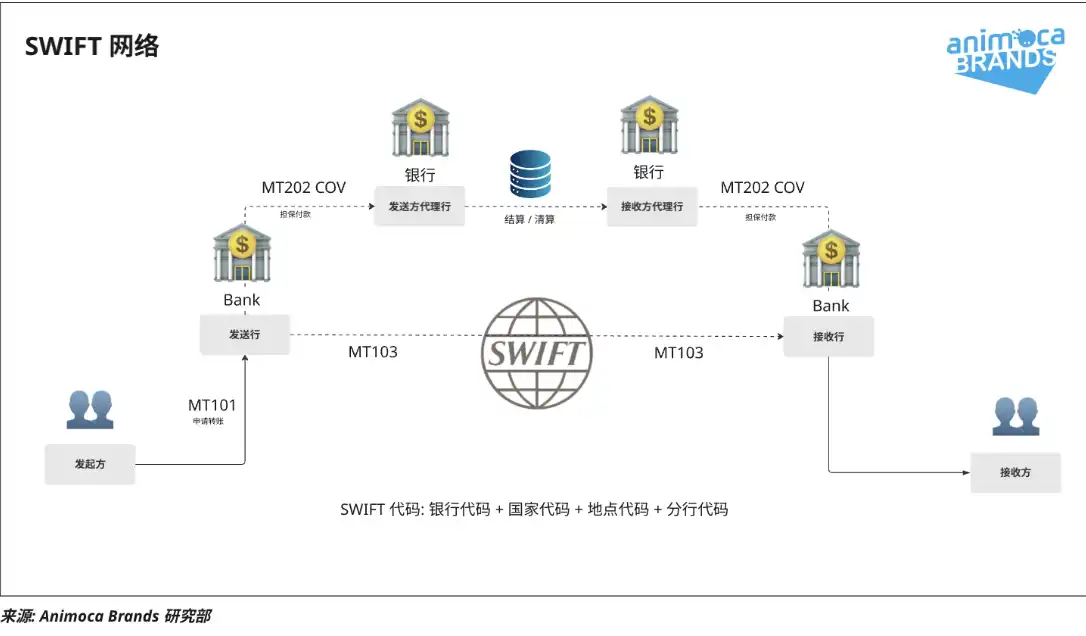
Cross-border transfers, or cross-border remittances, are smaller in scale compared to domestic transfers but are often criticized for their high costs (accounting for approximately 5-6% of the transaction value), long processing times (about 5-7 business days), and unpredictable outcomes (transfers may fail without reason).
As mentioned earlier, the root cause of this inefficiency is the lack of cross-border clearinghouse services. This means there are deficiencies in two key functions of fund transfers:
1. Communication: The remitting bank notifies the receiving bank of transfer information.
2. Settlement: The transfer of funds from the remitting bank to the receiving bank.
In the absence of clearing services, the current mainstream solution is telegraphic transfer, also known as SWIFT transfer. This method separates the above two functions:
- **Communication**: SWIFT handles interbank communication, transmitting transfer requests between the remitting bank, receiving bank, and intermediate banks.
- **Settlement**: Relies on interbank intermediation, utilizing internal bank transfers and domestic clearing services in various countries (e.g., USD via CHIPs).
Taking a USD transfer from Hong Kong to Brazil as an example, the general steps are as follows:
1. **Sending the message**: The bank in Hong Kong sends a SWIFT telegram to the bank in Brazil, notifying it of the transfer details.
2. **Selecting the route**: The remitting bank in Hong Kong chooses a settlement route and sends a SWIFT telegram to the intermediate bank.
3. **Fund settlement**:
- The remitting bank transfers USD from its Hong Kong branch to its New York branch via internal settlement.
- The New York branch sends the funds to the receiving bank’s New York branch via CHIPS.
- The receiving bank transfers the funds to Brazil via internal settlement.
Even in this simple scenario, the entire process takes 3-5 business days because each step requires daily settlement, and each intermediate point incurs fees, which accumulate at every step.
Such transfers can become more complex due to other factors, such as:
- **Use of local currency**: If the recipient in Brazil only accepts Brazilian reals, and the remitter only has Hong Kong dollars, the remitter must first convert Hong Kong dollars to USD to use the above fund intermediation route, and then the Brazilian bank converts it to reals.
- **Small banks**: Banks without a New York branch need to use a large bank with USD processing capabilities for intermediation, which further increases steps and costs.
However, under the traditional clearinghouse model, a country can also establish overseas clearing banks to allow non-domestic banks to participate in cross-border clearing of its currency (e.g., CIPS for RMB transfers). However, these efforts are still limited to a single currency and involve a slow, top-down expansion process. For example, the majority of offshore RMB transfers (73%) still rely on Hong Kong (similar to CHIPs via New York) and often use SWIFT rather than relying solely on CIPS.
### Remittance Operators: Existing Improvements for Cross-Border Payments
Remittance Operators (MTOs) are one of the innovative methods to address the inefficiency of cross-border transfers. MTOs are widely used in international e-commerce and personal remittances. Companies such as Western Union, Wise, and Airwallex are well-known brands in their respective regions and customer groups.
MTOs act like user-driven cross-border clearinghouses. The remitter deposits local currency into the MTO’s local bank account and notifies the MTO, thereby "depositing" funds into the MTO’s ledger. The MTO then calculates the equivalent amount in the recipient’s currency and transfers the corresponding amount from its bank account in the recipient’s country to the recipient’s local account, completing the "withdrawal."
This method improves efficiency by actually avoiding real cross-border fund flows. The "cross-border" part of each transaction is only recorded in the MTO’s ledger and then processed through the MTO’s accounts in the remitter’s and recipient’s countries. Therefore, the main cost for MTOs is not related to cross-border activities but to maintaining liquidity pools in the regions they serve. For regions with balanced capital flows (e.g., between Singapore and Hong Kong), liquidity pools remain roughly balanced and require little maintenance. When liquidity pools are unbalanced (e.g., from the U.S. to Mexico), MTOs reduce the cost per unit of transferred amount through bulk transfers and currency exchanges.
However, despite their efficiency, MTOs handle only a small portion of total cross-border transfers. Leading MTOs like Wise or Airwallex process less than $200 billion in transactions annually, generating approximately $1 billion in revenue. Another report states that the entire MTO industry generates $42 billion in annual revenue, so we estimate that MTO transfers account for approximately 3-5% of total cross-border remittances.
Several factors may prevent MTOs from dominating the cross-border transfer market:
- Large organizations generally prefer bank transfers for security reasons.
- Traditional telegraphic transfer networks offer broader coverage, while MTOs typically support only popular destinations and currencies.
- Limited liquidity pool sizes may restrict MTOs from handling large-value transfers.
In addition, MTOs incur additional operational costs, such as maintaining retail stores or corporate sales teams, which banks can amortize across their broader range of services.
Notably, cross-border transfers through cryptocurrency exchanges (e.g., Bitso) are more based on the MTO model, where core transfers occur on the exchange’s own ledger rather than utilizing the blockchain transfer capabilities of cryptocurrencies. The remitter deposits USD into the cryptocurrency exchange’s account, sends stablecoins to the recipient’s exchange account, and then withdraws funds to the recipient’s local bank account. In this process, the cryptocurrency exchange only updates its centralized ledger and manages deposits and withdrawals with local bank accounts. Cryptocurrencies primarily serve as an alternative way to fund accounts rather than being part of the underlying transfer mechanism.
### Stablecoins for Cross-Border Transfers: A New Approach Integrating MTOs and Banks
Stablecoins can integrate the MTO model into bank cross-border transfers. As mentioned earlier, stablecoins support the establishment of an "open clearinghouse," transcending geographical restrictions to enable direct single-currency transfers between any banks. For example, a USD transfer from Hong Kong to Brazil, which requires a three-stage relay via telegraphic transfer, can now be completed through a direct on-chain stablecoin transfer between two banks, taking only seconds and costing less than $1.
For transfers requiring currency exchange (e.g., Hong Kong dollars to Brazilian reals), a simple solution is to first convert Hong Kong dollars to USD or RMB for stablecoin cross-border settlement, then convert to reals after local withdrawal. This model is already a significant improvement over telegraphic transfers. A better cross-border transfer method is to integrate currency exchange into the "open clearinghouse." Once Hong Kong dollars and Brazilian reals have their own stablecoins, banks only need to handle blockchain deposits and withdrawals in local currencies, while exchanges between Hong Kong dollars and Brazilian reals can be conducted through on-chain trading liquidity pools. This way, banks do not need foreign exchange capabilities to participate in cross-border transfers, expanding the range of participating banks. Of course, this model requires compliant stablecoins for all involved currencies accepted by respective countries, which is still some time away.
Notably, SWIFT, as the most widely accepted communication platform among global banks, will still play a key role in cross-border transfers. While stablecoins can significantly improve the settlement process, transaction initiation still requires a shared platform to communicate transfer details. Just as card networks will continue to exist alongside stablecoin payments, SWIFT can still fulfill its role in interbank communication in a world of stablecoins.
### What Lies Ahead for Banks After Stablecoins?
"Open-source digital wallets" enabled by stablecoins may take away some of banks’ retail business. In the credit card market, which is mainly issued by banks, a shift in market preference toward stablecoin payments may reduce credit card usage, thereby lowering banks’ revenue from card issuance. This may prompt banks to shift from issuing credit cards to providing consumer credit and protection services by integrating with retailers or wallet applications. Additionally, personal deposits may increasingly exist on-chain as stablecoins rather than as bank account balances, prompting banks to find new ways to attract deposits, such as on-chain custody or Real-World Assets (RWA).
Meanwhile, bank infrastructure still has its advantages. For example, central bank-supported clearinghouses provide sufficient liquidity for large-value instant settlements. In contrast, stablecoin transfers require pre-funding of on-chain accounts, so traditional clearinghouses may still have an advantage in capital efficiency for large-value transfers. Furthermore, banks’ core capabilities, such as lending combined with strong risk control, remain indispensable to the modern economy. Finally, banks can still serve as gateways for users to access more financial and property services.
A potential change is that banks will gradually migrate their capabilities on-chain, either through their own transformation or the emergence of new banks, similar to how banks shifted from physical branches to online banking in the internet era. Users’ bank accounts may evolve into on-chain IDs, with banks acting only as custodians of on-chain assets. Banks’ recommended financial products may shift from funds and wealth management products to tokenized real-world assets (RWAs), and lending services may integrate into on-chain DeFi with the addition of banks’ risk control and compliance capabilities.
Ultimately, the modern financial system is built around banks: central banks create money, and commercial banks distribute and multiply money supply under regulation. Stablecoins bring new possibilities for providing banking services, forcing banks to adapt to new business models. Banks that fail to keep up may be eliminated, but the banking industry as a whole will still play an important role in the world.
### Conclusion
This article focuses on the main onshore use cases and potential of stablecoins under the established regulatory frameworks of major economies. There are many more topics related to stablecoins, such as on-chain native stablecoins, interest-bearing stablecoins, competitors to stablecoins (e.g., central bank digital currencies (CBDCs) or tokenized deposits), and the political motivations behind promoting stablecoins. We will explore these topics in future articles.
**Disclaimer**: The views in this article are solely those of the author and do not constitute investment advice on this platform. This platform makes no guarantees regarding the accuracy, completeness, originality, or timeliness of the information in the article, nor does it assume any liability for losses arising from the use or reliance on such information.
Contact: Sarah
Phone: +1 6269975768
Tel: +1 6269975768
Email: xttrader777@gmail.com
Add: Lee Garden One, 33 Hysan Avenue, Causeway Bay, Hong Kong.